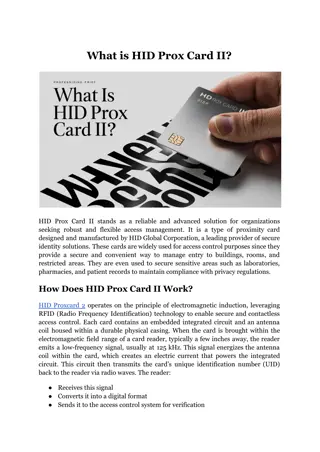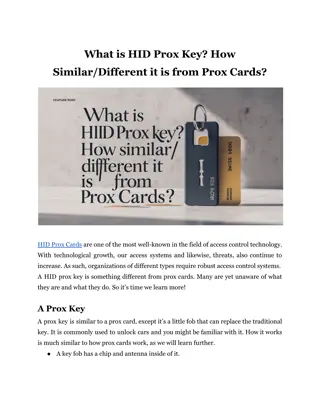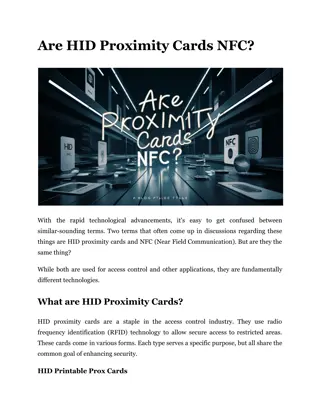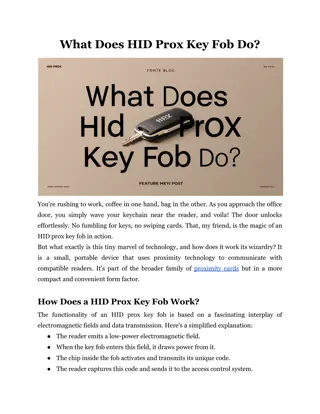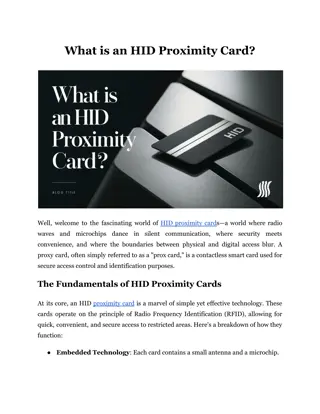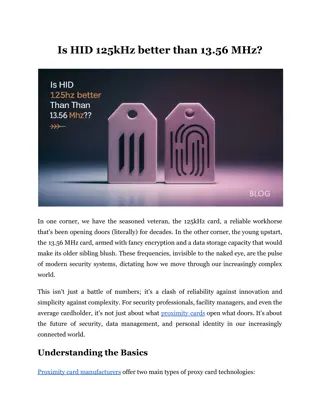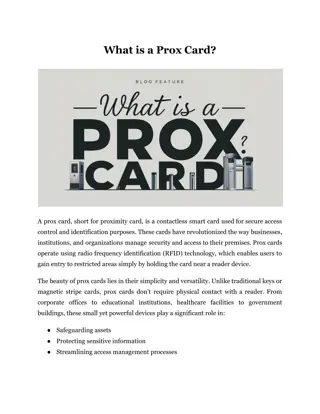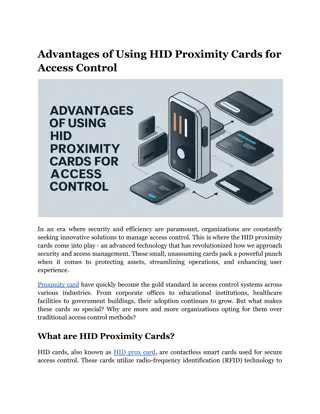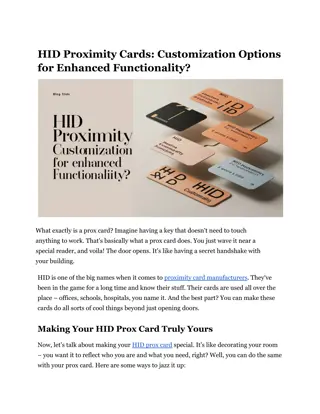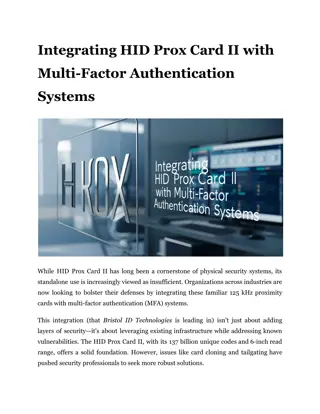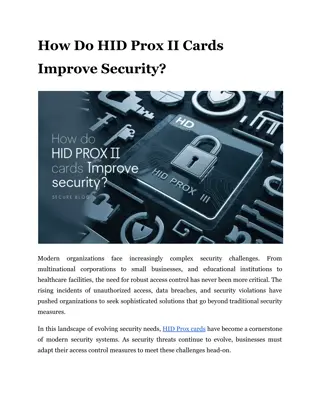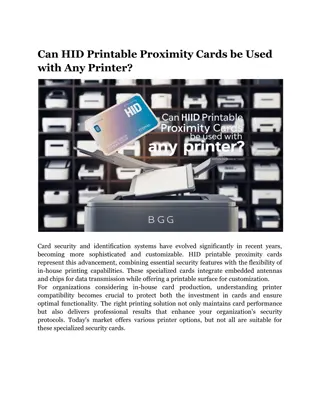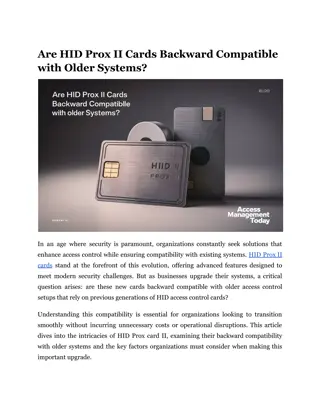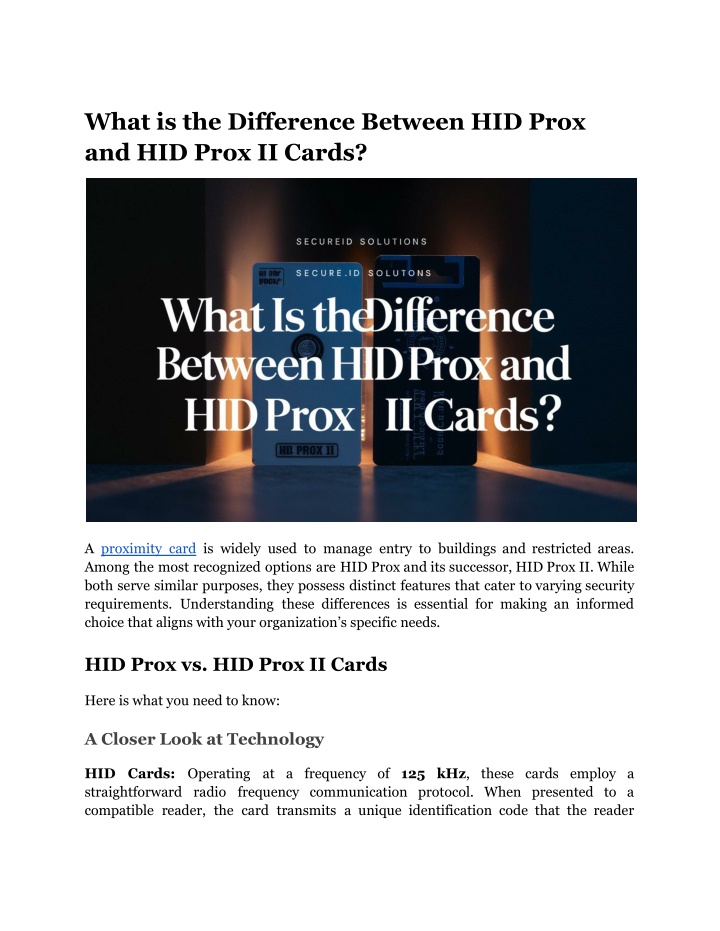
What is the Difference Between HID Prox and HID Prox II Cards?
Discover the main differences between HID Prox and HID Prox II cards to choose the right access control solution for your needs.
Download Presentation

Please find below an Image/Link to download the presentation.
The content on the website is provided AS IS for your information and personal use only. It may not be sold, licensed, or shared on other websites without obtaining consent from the author. If you encounter any issues during the download, it is possible that the publisher has removed the file from their server.
You are allowed to download the files provided on this website for personal or commercial use, subject to the condition that they are used lawfully. All files are the property of their respective owners.
The content on the website is provided AS IS for your information and personal use only. It may not be sold, licensed, or shared on other websites without obtaining consent from the author.
E N D
Presentation Transcript
What is the Difference Between HID Prox and HID Prox II Cards? A proximity card is widely used to manage entry to buildings and restricted areas. Among the most recognized options are HID Prox and its successor, HID Prox II. While both serve similar purposes, they possess distinct features that cater to varying security requirements. Understanding these differences is essential for making an informed choice that aligns with your organization s specific needs. HID Prox vs. HID Prox II Cards Here is what you need to know: A Closer Look at Technology HID Cards: Operating at a frequency of 125 kHz, these cards employ a straightforward radio frequency communication protocol. When presented to a compatible reader, the card transmits a unique identification code that the reader
verifies against a database. This simplicity makes it easy to implement; however, the lack of encryption leaves it vulnerable to interception and cloning. HID Prox II Cards: Similar in frequency, the Prox II variant also operates at 125 kHz but enhances communication with an encrypted protocol. This additional security measure ensures that the data exchanged between the card and the reader remains protected. Unauthorized individuals face significant challenges in attempting to replicate or intercept these cards, making them suitable for environments that require enhanced security. Security Features Comparison HID Proximity Cards: While these cards provide basic security measures, their design lacks advanced features. The absence of encryption means that the ID signal is susceptible to duplication, posing a considerable risk in sensitive areas. HID Prox II Cards: In contrast, the Prox II cards incorporate robust security measures. The encryption and anti-counterfeiting features significantly reduce the risk of unauthorized access. This makes them ideal for organizations that prioritize safeguarding sensitive information and facilities. Data Storage Capacities HID Prox Cards: Limited in data storage, these cards primarily hold a unique identifier for access control. This minimalist design suffices for straightforward applications but lacks flexibility for organizations needing additional functionality. HID Prox II Cards: Prox II cards offer enhanced storage capabilities, allowing them to accommodate user-profiles and access logs. This versatility enables organizations to integrate multiple applications into a single card, streamlining their access management processes. Performance and Read Range HID Cards: Typically, these cards have a read range of 3 to 6 inches. This requirement can slow access in busy environments, where quick entry is necessary. Performance may also be affected by electronic interference or physical barriers in the surroundings. Prox II Cards: These cards often feature an extended read range, allowing users to access readers from a greater distance. This improvement enhances user experience and
efficiency, especially in high-traffic areas, while maintaining reliable performance even in challenging conditions. Durability and Longevity HID Cards: Although built for durability, the lifespan of these cards may not match that of their Prox II counterparts. Frequent use can lead to wear and tear, resulting in higher replacement rates over time. Prox II Cards: Crafted from superior materials, Prox II cards exhibit enhanced durability, leading to a longer lifespan. This means fewer replacements and ultimately lower costs for organizations managing a large number of users. Cost Considerations HID Prox Cards: One of the advantages of these cards is their lower initial cost. They offer a budget-friendly solution for smaller organizations needing a reliable access management system without significant upfront expenses. HID Prox II Cards: Conversely, Prox II cards generally carry a higher price tag due to their advanced features. However, organizations should consider the long-term value, as the enhanced security and durability may lead to reduced overall expenses, especially for businesses planning to expand or increase their security measures. Use Cases and Applications HID Cards: These cards are well-suited for basic access control in environments like small offices or residential complexes. Their straightforward design allows for easy integration into existing systems, making them a practical choice for organizations with uncomplicated security needs. HID II Cards: These cards excel in multi-application settings, such as larger businesses, educational institutions, or corporate campuses. The added flexibility and enhanced security make them a valuable asset for organizations looking to optimize their access control systems while ensuring high levels of protection. Choosing the Right Card for Your Needs The decision between HID Prox and Prox II cards ultimately depends on your organization's specific requirements.
If your organization has basic access control needs and operates within a limited budget, an HID Prox card might be the right choice. Their reliability and ease of use make them suitable for smaller facilities or environments where advanced security features are not as critical. For organizations that prioritize security and have plans for future growth, HID Prox II cards are the better option. Their enhanced security features, extended read range, and increased memory capacity provide a robust solution for more complex access control requirements. Important Implementation Considerations Before making a final decision, consider these factors: 1. Compatibility with Existing Systems: Ensure that your current access control system can accommodate the chosen card type. Some older systems may only support HID Prox cards. 2. Transition Costs: If you plan to switch from HID Prox to HID Prox II, factor in any costs related to upgrading readers and systems. The benefits of the newer technology must be weighed against these potential expenses. 3. Staff Training: Regardless of which card you choose, training your staff on the new system is vital for a smooth transition. Familiarizing employees with how to use the cards effectively will enhance the overall user experience. 4. Long-Term Vision: Think about your organization s future goals. If you foresee a need for expansion or increased security, investing in HID Prox II cards may provide the flexibility and enhancements you require. The Future of Proximity Cards As technology advances, the landscape of access control continues to evolve. Here are a few trends to watch for: 1. Mobile Access Solutions: Many organizations are shifting toward mobile access, enabling users to gain entry using their smartphones or other mobile devices. While this does not entirely replace proximity cards, it provides a modern alternative for those who prefer it.
2. Biometric Authentication: The integration of biometric systems with proximity cards is becoming increasingly common. This multifactor approach to security can enhance overall safety and provide a more robust access control solution. 3. Cloud-Based Systems: The move toward cloud-based access control systems is gaining traction, offering centralized management and real-time monitoring capabilities. This trend can significantly improve efficiency for larger organizations. Conclusion The choice between HID Prox and Prox II cards should stem from a clear understanding of your organization s security and operational requirements. Prox cards provide a dependable solution for straightforward access control, while their Prox II counterparts offer advanced features and enhanced security for more complex environments. At Bristol ID Technologies, we provide top-quality proximity cards tailored to meet your access control needs. Our expert team is ready to guide you in selecting the right solution for your unique requirements. Contact us today to explore our range of prox cards and discover how we can help you achieve a safer and more efficient environment. FAQs Can I use prox cards with my existing access control system? Yes, most proximity cards are compatible with a wide range of access control systems. Experts can help ensure seamless integration with your current setup. Are there any special considerations for using prox cards outdoors? While prox cards are designed to be durable, exposure to extreme weather conditions can impact their longevity. It s advisable to choose cards specifically rated for outdoor use if they will be exposed to the elements. What is the typical read range for prox cards?
The read range for standard HID Prox cards is usually between 3 to 6 inches. However, HID Prox II cards often feature an extended read range, allowing access from a greater distance. Can prox cards be programmed for multiple applications? Yes, many prox cards, especially HID Prox II cards, can be programmed for various applications, including access control, time tracking, and cashless payments. This flexibility helps streamline operations within your organization. What security measures do you recommend for using prox cards? To maximize security, experts recommend using encrypted prox cards, implementing strict access control policies, and regularly updating your access control system to ensure it remains secure against emerging threats. Site Article: What is the Difference Between HID Prox and HID Prox II Cards?




